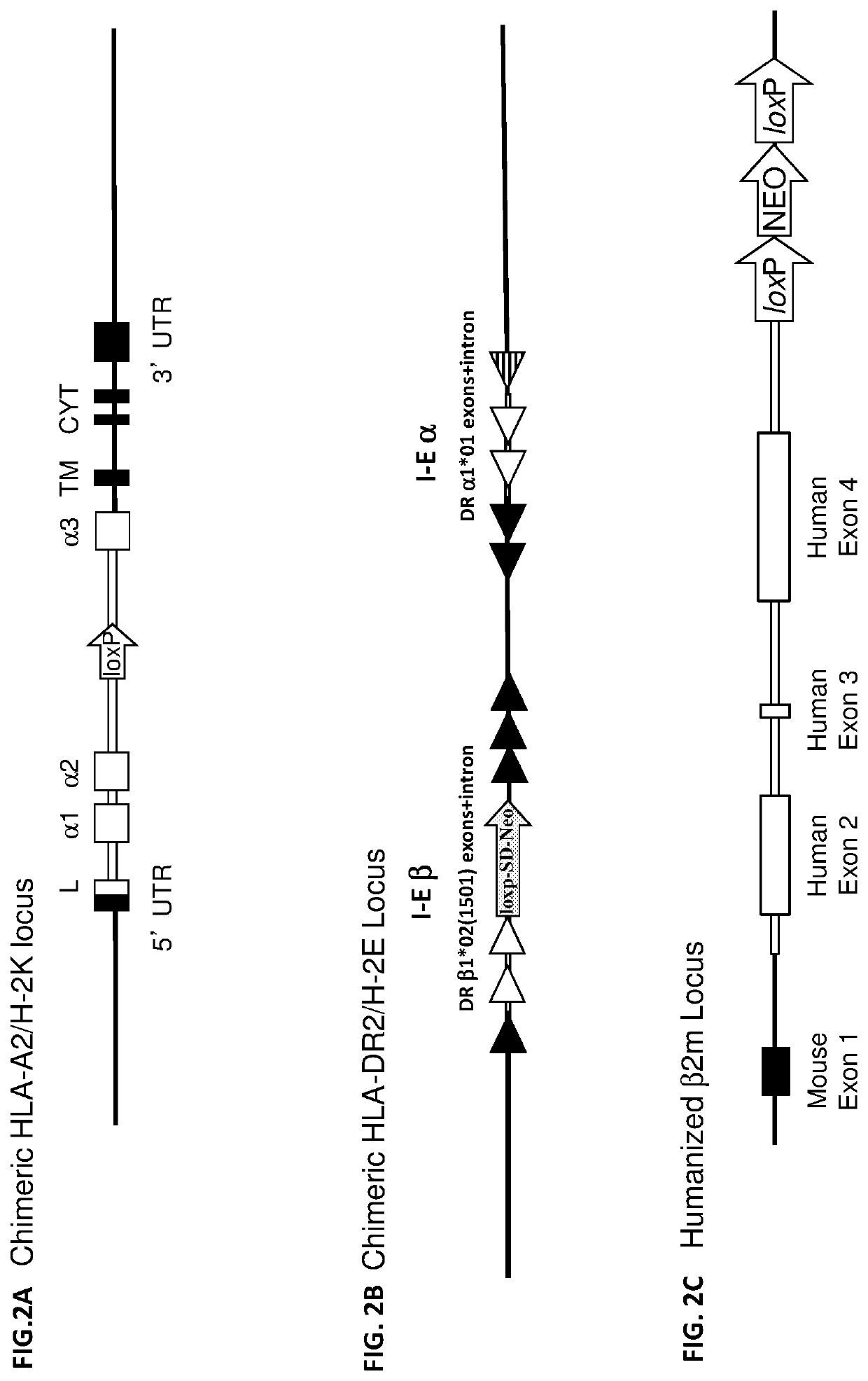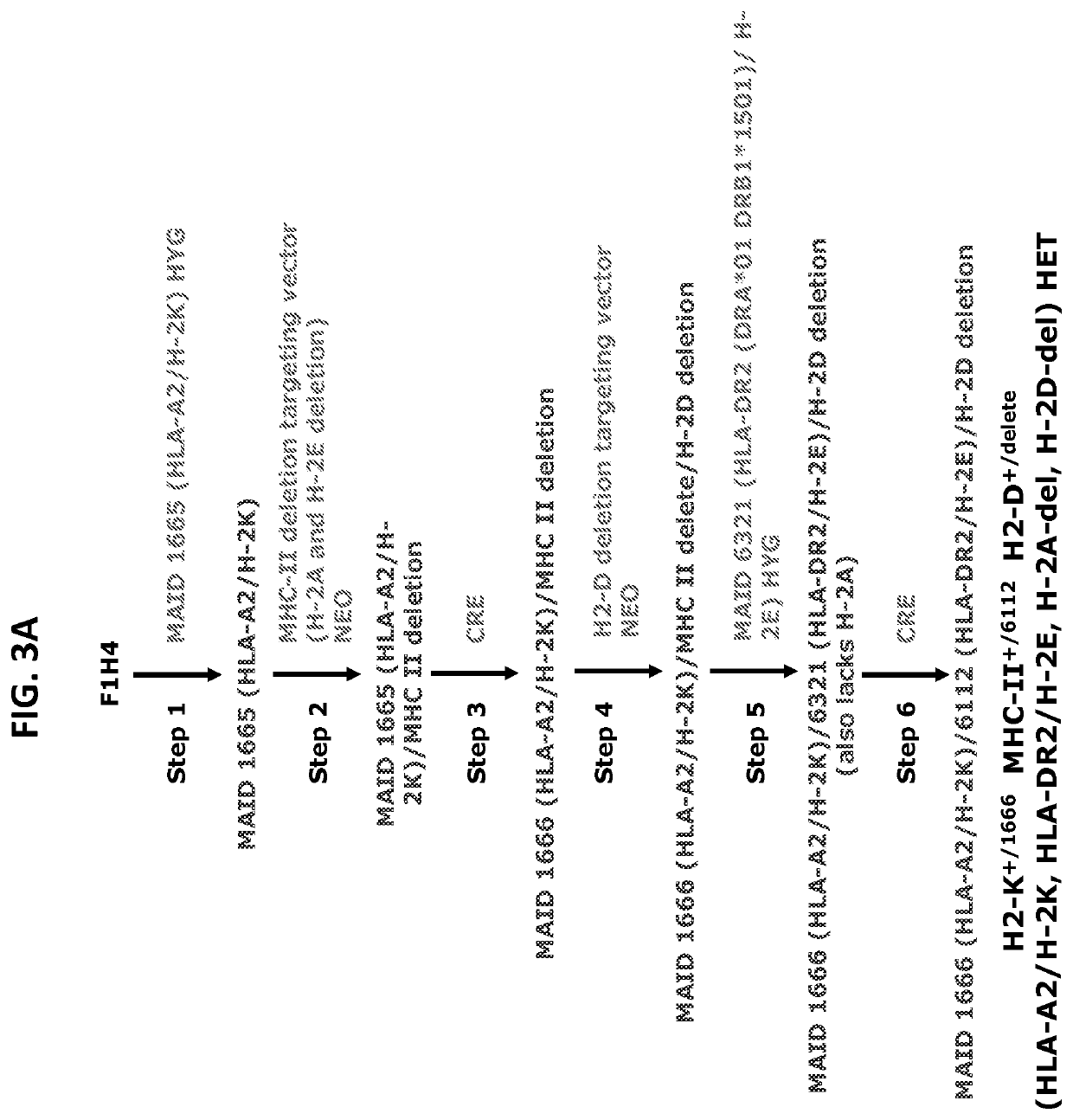Humanized T cell mediated immune responses in non-human animals
a technology of humanized t cells and immune responses, applied in the field of non-human animals, can solve problems such as destruction of cells presenting such peptides
- Summary
- Abstract
- Description
- Claims
- Application Information
AI Technical Summary
Problems solved by technology
Method used
Image
Examples
example 1
Generation of Humanized MHC Mice
[0315]The various steps involved in engineering a mouse comprising humanized MHC I and MHC II loci, with corresponding and additional endogenous MHC I and MHC II loci deletions (HLA-A2 / H-2K, HLA-DR2 / H-2E, H-2A-del, H-2D-del) are depicted in FIG. 3A. Detailed description of the steps appears below.
example 1.1
Generation and Characterization of Humanized MHC I Mice
[0316]Generation of humanized MHC I mice has previously been described in U.S. Patent Publication No. 20130111617, incorporated herein by reference. Briefly, the mouse H-2K gene was humanized in a single step by construction of a unique targeting vector from human and mouse bacterial artificial chromosome (BAC) DNA using VELOCIGENE® technology (see, e.g., U.S. Pat. No. 6,586,251 and Valenzuela et al. (2003) High-throughput engineering of the mouse genome coupled with high-resolution expression analysis. Nat. Biotech. 21(6): 652-659). DNA from mouse BAC clone RP23-173k21 (Invitrogen) was modified by homologous recombination to replace the genomic DNA encoding the α1, α2 and α3 domains of the mouse H-2K gene with human genomic DNA encoding the α1, α2 and α3 subunits of the human HLA-A gene (FIG. 2A).
[0317]Specifically, the genomic sequence encoding the mouse the α1, α2 and α3 subunits of the H-2K gene is replaced with the human ge...
example 1.2
Generation of Mouse ES Cells Comprising MHC I and MHC II Loci Deletions
[0322]Deletion of endogenous MHC II loci is described in U.S. Patent Application Number No. 20130111616, incorporated herein by reference. Briefly, the targeting vector for introducing a deletion of the endogenous MHC class II H-2Ab1, H-2Aa, H-2Eb1, H-2Eb2, and H-2Ea genes was made using VELOCIGENE® genetic engineering technology (see, e.g., U.S. Pat. No. 6,586,251 and Valenzuela et al., supra). Bacterial Artificial Chromosome (BAC) RP23-458i22 (Invitrogen) DNA was modified to delete the endogenous MHC class II genes H-2Ab1, H-2Aa, H-2Eb1, H-2Eb2, and H-2Ea.
[0323]Specifically, upstream and downstream homology arms were derived by PCR of mouse BAC DNA from locations 5′ of the H-2Ab1 gene and 3′ of the H-2Ea gene, respectively. These homology arms were used to make a cassette that deleted ˜79 kb of RP23-458i22 comprising genes H-2Ab1, H-2Aa, H-2Eb1, H-2Eb2, and H-2Ea of the MHC class II locus by bacterial homologou...
PUM
 Login to View More
Login to View More Abstract
Description
Claims
Application Information
 Login to View More
Login to View More - R&D
- Intellectual Property
- Life Sciences
- Materials
- Tech Scout
- Unparalleled Data Quality
- Higher Quality Content
- 60% Fewer Hallucinations
Browse by: Latest US Patents, China's latest patents, Technical Efficacy Thesaurus, Application Domain, Technology Topic, Popular Technical Reports.
© 2025 PatSnap. All rights reserved.Legal|Privacy policy|Modern Slavery Act Transparency Statement|Sitemap|About US| Contact US: help@patsnap.com



